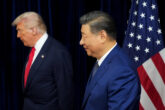October 24, 2024
America Needs Clear Standards for China Tech Decoupling
Last month, the Biden administration proposed a rule to effectively sweep Chinese cars from the U.S. market. If enacted, the rule would ban the sale or import of any “connected vehicle” with certain Chinese technology. Today’s cars are essentially smartphones on wheels, equipped with increasingly sophisticated external connections, software, and sensors that constantly monitor the world around them. The administration rightly worries that Beijing could exploit these underlying technologies to turn American vehicles into unwitting surveillance vans for the Chinese Communist Party—or worse, to hijack them entirely.
Policymakers are slowly awaking to a rise in China’s cyber threat and the United States’ digital vulnerability. If there is a growing consensus to expand the country’s decoupling from Chinese tech, however, there is still no clear vision for how to do so responsibly.
This broad, virtually unchecked authority to ban Chinese apps and products resembles more of a loaded gun than a considered policy.
Washington must soon move beyond ad hoc bans against specific apps (such as TikTok) and categories (such as connected vehicles) and articulate a broader policy that identifies clear risks and limiting principles to inform which Chinese technologies Washington can tolerate in the U.S. market, and which it cannot. Absent this, policymakers risk barreling toward an improvisational, potentially vast tech decoupling from China with poorly understood consequences for American consumers, industry, and foreign policy.
The absence of a clear risk mitigation framework for Chinese tech creates uncertainty for the businesses, factories, and farmers who rightly wonder if their Chinese-linked products and components will be the next mole that Washington decides to whack. Today’s vague and easily abused executive power to ban Chinese tech also gives Beijing pretext to justify its own arbitrary restrictions on the $154 billion of U.S. exports to its massive market.
Read the full article on Foreign Policy.
More from CNAS
-
Transatlantic Security / Technology & National Security
Look Before We Leap on Artificial IntelligenceThis article was originally published on The Dispatch. A debate about the role that artificial intelligence should and will play in society, and how it will affect humanity fo...
By Jon B. Wolfsthal
-
Technology & National Security
Caleb Withers on the Cybersecurity Frontier in the Age of AICaleb Withers, research associate at the Center for a New American Security, joins Kevin Frazier, the AI Innovation and Law Fellow at the University of Texas School of Law and...
By Caleb Withers
-
Technology & National Security
Prepared, Not ParalyzedExecutive Summary The Trump administration has embraced a pro-innovation approach to artificial intelligence (AI) policy. Its AI Action Plan, released July 2025, underscores t...
By Janet Egan, Spencer Michaels & Caleb Withers
-
Indo-Pacific Security / Technology & National Security
Sharper: Tech + ChinaRecent talks between President Donald Trump and Chinese Communist Party General Secretary Xi Jinping placed a spotlight on emerging technologies, from high-end chips to minera...
By Charles Horn & Sevi Silvia




